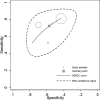EZSCAN for undiagnosed type 2 diabetes mellitus: A systematic review and meta-analysis
- PMID: 29084286
- PMCID: PMC5662214
- DOI: 10.1371/journal.pone.0187297
EZSCAN for undiagnosed type 2 diabetes mellitus: A systematic review and meta-analysis
Abstract
Objectives: The EZSCAN is a non-invasive device that, by evaluating sweat gland function, may detect subjects with type 2 diabetes mellitus (T2DM). The aim of the study was to conduct a systematic review and meta-analysis including studies assessing the performance of the EZSCAN for detecting cases of undiagnosed T2DM.
Methodology/principal findings: We searched for observational studies including diagnostic accuracy and performance results assessing EZSCAN for detecting cases of undiagnosed T2DM. OVID (Medline, Embase, Global Health), CINAHL and SCOPUS databases, plus secondary resources, were searched until March 29, 2017. The following keywords were utilized for the systematic searching: type 2 diabetes mellitus, hyperglycemia, EZSCAN, SUDOSCAN, and sudomotor function. Two investigators extracted the information for meta-analysis and assessed the quality of the data using the Revised Version of the Quality Assessment of Diagnostic Accuracy Studies (QUADAS-2) checklist. Pooled estimates were obtained by fitting the logistic-normal random-effects model without covariates but random intercepts and using the Freeman-Tukey Arcsine Transformation to stabilize variances. Heterogeneity was also assessed using the I2 measure. Four studies (n = 7,720) were included, three of them used oral glucose tolerance test as the gold standard. Using Hierarchical Summary Receiver Operating Characteristic model, summary sensitivity was 72.0% (95%CI: 60.0%- 83.0%), whereas specificity was 56.0% (95%CI: 38.0%- 74.0%). Studies were very heterogeneous (I2 for sensitivity: 79.2% and for specificity: 99.1%) regarding the inclusion criteria and bias was present mainly due to participants selection.
Conclusions: The sensitivity of EZSCAN for detecting cases of undiagnosed T2DM seems to be acceptable, but evidence of high heterogeneity and participant selection bias was detected in most of the studies included. More studies are needed to evaluate the performance of the EZSCAN for undiagnosed T2DM screening, especially at the population level.
Conflict of interest statement
Figures


References
-
- Danaei G, Finucane MM, Lu Y, Singh GM, Cowan MJ, Paciorek CJ, et al. National, regional, and global trends in fasting plasma glucose and diabetes prevalence since 1980: systematic analysis of health examination surveys and epidemiological studies with 370 country-years and 2.7 million participants. Lancet. 2011;378(9785):31–40. doi: 10.1016/S0140-6736(11)60679-X . - DOI - PubMed
-
- Risk Factor Collaboration N.C.D. Worldwide trends in diabetes since 1980: a pooled analysis of 751 population-based studies with 4.4 million participants. Lancet. 2016;387(10027):1513–30. doi: 10.1016/S0140-6736(16)00618-8 . - DOI - PMC - PubMed
-
- Kontis V, Mathers CD, Rehm J, Stevens GA, Shield KD, Bonita R, et al. Contribution of six risk factors to achieving the 25x25 non-communicable disease mortality reduction target: a modelling study. Lancet. 2014;384(9941):427–37. doi: 10.1016/S0140-6736(14)60616-4 . - DOI - PubMed
-
- World Health Organization. Global Health Estimates: Deaths by Cause, Age, Sex and Country, 2000–2012. Geneva, Switzerland: WHO, 2014.
-
- Federation ID. IDF Diabetes Atlas 6th edition Brussels, Belgium: IDF, 2013.
Publication types
MeSH terms
Grants and funding
LinkOut - more resources
Full Text Sources
Other Literature Sources
Medical

